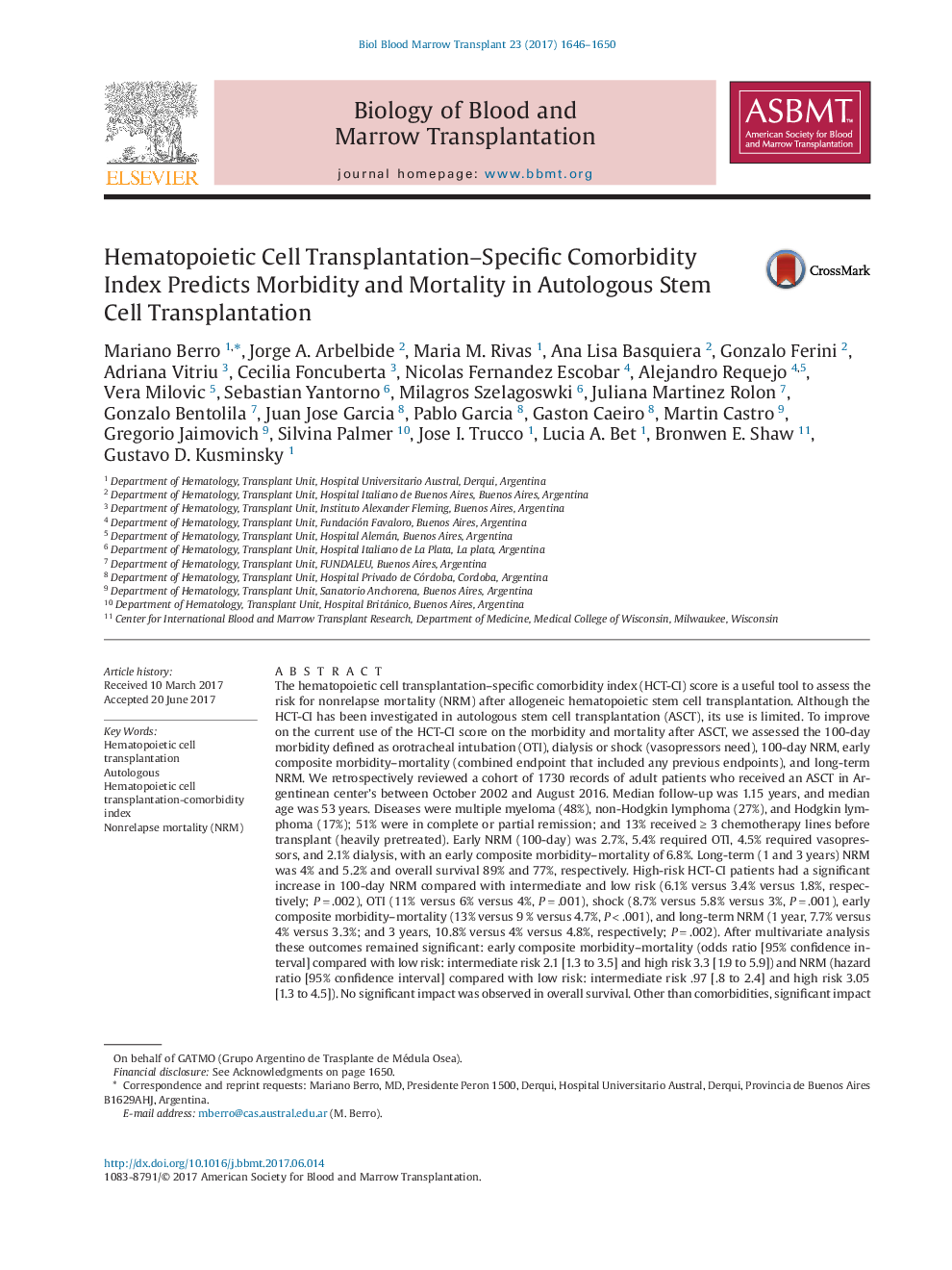| کد مقاله | کد نشریه | سال انتشار | مقاله انگلیسی | نسخه تمام متن |
|---|---|---|---|---|
| 5524049 | 1546236 | 2017 | 5 صفحه PDF | دانلود رایگان |
- We validated the association of HCT-CI score in autologous transplantation NRM.
- HCT-CI score is associated with early morbidity outcomes.
- Other patient characteristics are associated with long-term NRM.
The hematopoietic cell transplantation-specific comorbidity index (HCT-CI) score is a useful tool to assess the risk for nonrelapse mortality (NRM) after allogeneic hematopoietic stem cell transplantation. Although the HCT-CI has been investigated in autologous stem cell transplantation (ASCT), its use is limited. To improve on the current use of the HCT-CI score on the morbidity and mortality after ASCT, we assessed the 100-day morbidity defined as orotracheal intubation (OTI), dialysis or shock (vasopressors need), 100-day NRM, early composite morbidity-mortality (combined endpoint that included any previous endpoints), and long-term NRM. We retrospectively reviewed a cohort of 1730 records of adult patients who received an ASCT in Argentinean center's between October 2002 and August 2016. Median follow-up was 1.15 years, and median age was 53 years. Diseases were multiple myeloma (48%), non-Hodgkin lymphoma (27%), and Hodgkin lymphoma (17%); 51% were in complete or partial remission; and 13% received ⥠3 chemotherapy lines before transplant (heavily pretreated). Early NRM (100-day) was 2.7%, 5.4% required OTI, 4.5% required vasopressors, and 2.1% dialysis, with an early composite morbidity-mortality of 6.8%. Long-term (1 and 3 years) NRM was 4% and 5.2% and overall survival 89% and 77%, respectively. High-risk HCT-CI patients had a significant increase in 100-day NRM compared with intermediate and low risk (6.1% versus 3.4% versus 1.8%, respectively; Pâ=â.002), OTI (11% versus 6% versus 4%, Pâ=â.001), shock (8.7% versus 5.8% versus 3%, Pâ=â.001), early composite morbidity-mortality (13% versus 9 % versus 4.7%, Pâ<â.001), and long-term NRM (1 year, 7.7% versus 4% versus 3.3%; and 3 years, 10.8% versus 4% versus 4.8%, respectively; Pâ=â.002). After multivariate analysis these outcomes remained significant: early composite morbidity-mortality (odds ratio [95% confidence interval] compared with low risk: intermediate risk 2.1 [1.3 to 3.5] and high risk 3.3 [1.9 to 5.9]) and NRM (hazard ratio [95% confidence interval] compared with low risk: intermediate risk .97 [.8 to 2.4] and high risk 3.05 [1.3 to 4.5]). No significant impact was observed in overall survival. Other than comorbidities, significant impact was observed for heavily pretreated patients, age ⥠55 years, non-Hodgkin lymphoma, and bendamustine-etoposide-citarabine-melphalan conditioning. We confirmed that the HCT-CI had a significant impact on NRM after ASCT, and these findings are mainly due to early toxicity express as 100-day NRM and the 3 main morbidity outcomes as well as the composite endpoint.
Journal: Biology of Blood and Marrow Transplantation - Volume 23, Issue 10, October 2017, Pages 1646-1650
